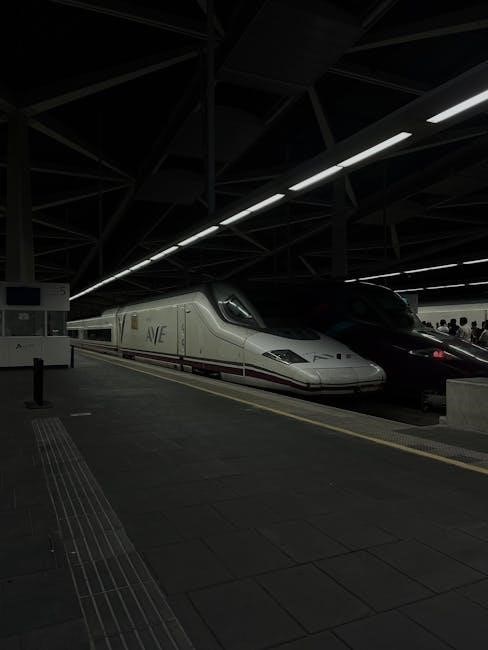Historical Background of “Ave Verum Corpus”
Composed in June 1791 for Anton Stoll, choirmaster in Baden, near Vienna, Ave Verum Corpus marks one of Mozart’s final works, written during a period of personal and financial challenges.

1.1. Date and Circumstances of Composition
Mozart composed Ave Verum Corpus, K. 618, in June 1791, during a challenging period in his life. The exact date of completion is noted as June 17 or 18, 1791. This motet was written near the end of his career, when he faced financial difficulties and poor health. Despite these hardships, the piece exudes tranquility and spiritual depth. It was created for the feast of Corpus Christi in Baden, a spa town near Vienna where Mozart’s wife, Constanze, often sought treatment. The work was intended for the local church choir, reflecting Mozart’s enduring connection to sacred music. The manuscript, preserved to this day, provides insight into the composer’s meticulous craftsmanship. This piece stands as a testament to Mozart’s ability to create profound beauty amidst adversity, blending simplicity with emotional richness.
1.2. The Role of Anton Stoll in Commissioning the Work
Anton Stoll, a schoolteacher and choirmaster at the parish church of St. Stephan in Baden, played a pivotal role in the creation of Ave Verum Corpus. Stoll, an acquaintance of Mozart, requested the composition for use in the liturgical celebrations at his church. His position in the community and his connection to Mozart provided the impetus for the work. Stoll’s commission reflects the strong ties Mozart maintained with local musical communities, even during his Vienna years. The request from Stoll not only provided Mozart with a creative outlet but also offered financial support during a particularly difficult time. Stoll’s initiative ensured that this timeless piece would be brought to life, contributing to the rich legacy of Mozart’s sacred music. His role underscores the importance of patronage and personal connections in fostering artistic creation.
1.3. The Significance of Baden as the Place of Composition

Baden, a picturesque spa town near Vienna, holds special significance as the location where Mozart composed Ave Verum Corpus in June 1791. Known for its thermal springs and serene environment, Baden was a place of retreat and healing, where Mozart’s wife, Constanze, often sought treatment. The tranquil atmosphere of Baden likely influenced the calm and reflective nature of the piece. Additionally, Baden’s historical connection to music and its role as a cultural hub in Austria made it an inspiring setting for artistic creation. The composition of Ave Verum Corpus during Mozart’s visit underscores the town’s legacy as a source of creative inspiration. This setting, combined with the personal circumstances of Mozart’s life, including his financial struggles and declining health, adds depth to the work’s historical context. Baden thus serves as a symbolic backdrop for one of Mozart’s final and most cherished compositions.

Composition and Musical Structure
Ave Verum Corpus is a motet in D major, scored for chorus and orchestra, showcasing Mozart’s mastery of choral writing. Its serene and devotional character reflects the sacred text, blending simplicity with profound musical depth.
2.1. The Manuscript and Its Preservation
The manuscript of Ave Verum Corpus is dated June 18, 1791, and is preserved on a single sheet of paper from Mozart’s personal stock. It is remarkably well-preserved, with minimal corrections, reflecting Mozart’s compositional clarity. The manuscript resides in the collection of the Austrian National Library in Vienna, where it has been carefully maintained to ensure its longevity. Its condition speaks to the meticulous care taken to preserve historical musical artifacts. The manuscript serves as a vital historical document, offering insights into Mozart’s creative process and the musical practices of his time. Its survival underscores the enduring legacy of Mozart’s final sacred work, written during a period of personal and artistic challenges.
2.2. The Musical Setting of the Latin Text
Mozart’s Ave Verum Corpus is a masterful setting of the Latin hymn, balancing simplicity with profound musical depth. The motet is written for chorus and orchestra, with a gentle, serene quality that reflects the sacred text. The Latin words, a 14th-century Eucharistic hymn, are set to music that enhances their spiritual meaning. Mozart’s composition features rich harmonies and intricate counterpoint, creating a sense of reverence and contemplation. The orchestration is sparse yet effective, with strings and woodwinds supporting the choral voices. The setting captures the devotional essence of the text, with each phrase carefully shaped to convey emotion and faith. Despite its brevity, the work showcases Mozart’s ability to transform a traditional hymn into a timeless musical expression of worship and devotion.
2.3. The Original Scoring for Chorus and Orchestra
Mozart’s Ave Verum Corpus is originally scored for a mixed chorus and a small orchestra, reflecting the intimate nature of the work. The choral arrangement is for four vocal parts (SATB), with the orchestra consisting of strings, woodwinds (oboes and bassoons), and brass (trumpets and trombones). The orchestration is notably restrained, allowing the vocal lines to remain prominent while providing subtle harmonic and rhythmic support. The strings, particularly the violins, often double the choral melodies, creating a sense of unity and clarity. The woodwinds add color and texture, while the brass underscores key moments of the text. This scoring ensures the piece retains its sacred simplicity, with the orchestra enhancing the emotional depth without overpowering the chorus. The arrangement is typical of Mozart’s late sacred works, balancing elegance and reverence to complement the Latin hymn’s devotional character.

Musical Analysis
Mozart’s Ave Verum Corpus exhibits serene harmonies, flowing melodies, and masterful counterpoint, creating a work of profound simplicity and spiritual depth, reflecting his late compositional style and emotional maturity.
3.1. Harmonic and Melodic Characteristics
Mozart’s Ave Verum Corpus is characterized by its serene and simple harmonic structure, with a focus on diatonic progressions that create a sense of stability and devotion. The piece is written in D major, a key often associated with brilliance and grandeur, yet here it conveys intimacy and tranquility. The melodies are flowing and lyrical, with a homogeneous texture that unites the voices and instruments. Suspended dissonances are used sparingly but effectively to heighten emotional moments, such as in the plea for mercy. The interplay between the chorus and orchestra is balanced, with the strings providing a warm, accompanimental foundation. Mozart’s mastery of harmony is evident in the way he progresses through chords, often resolving tensions with a sense of inevitability. The overall melodic and harmonic design reflects Mozart’s late-classical style, blending simplicity with profound expressiveness, making the work a timeless example of sacred music.
3.2. The Use of Counterpoint in the Motet
Mozart’s Ave Verum Corpus showcases a subtle yet effective use of counterpoint, particularly in its choral writing. While the piece is primarily homophonic, with a clear dominance of vertical harmonies, there are moments where independent melodic lines intertwine to create a richer texture. The counterpoint is employed sparingly but with great precision, often to emphasize specific textual phrases, such as “vera gluten” or “in mortis examine.” These passages reveal Mozart’s mastery of contrapuntal techniques, inherited from his study of earlier composers like Bach. However, the counterpoint here is never overly complex, remaining subordinate to the overall serenity of the piece. Instead, it serves to enhance the devotional character of the text, creating a sense of depth without disrupting the work’s tranquil atmosphere. This balance between simplicity and contrapuntal artistry underscores Mozart’s ability to adapt traditional techniques to contemporary expressive needs.
3.3. Rhythmic and Temporal Features
Mozart’s Ave Verum Corpus is characterized by a serene and steady rhythmic structure, reflecting the sacred nature of the text. The piece is written in 4/4 time, with a moderate tempo that supports its contemplative atmosphere. The vocal lines are primarily syllabic, with a straightforward setting of the Latin text that avoids overly complex rhythms. This simplicity allows the words to shine, emphasizing their devotional meaning. The orchestral accompaniment, featuring strings and occasional wind interjections, provides a subtle rhythmic foundation, maintaining a steady pulse without overpowering the chorus. Mozart occasionally employs syncopation and brief pauses to create moments of tension and release, adding emotional depth to the otherwise calm texture. These rhythmic nuances, combined with the piece’s temporal clarity, contribute to its timeless and universal appeal. The motet’s rhythmic restraint underscores its liturgical purpose, making it suitable for both historical and modern worship settings.

Historical Significance
Ave Verum Corpus is one of Mozart’s final sacred works, showcasing his enduring contribution to liturgical music. Its serene beauty and harmonious structure have influenced composers, remaining a revered classical masterpiece.
4.1. “Ave Verum Corpus” in Mozart’s Late Works
Ave Verum Corpus, composed in June 1791, stands as one of Mozart’s final completed works, created just months before his death. It reflects his mastery of sacred music, blending simplicity with profound spirituality. Written during a period of personal and financial struggles, the piece embodies a serene and peaceful quality, contrasting with the turmoil of his later life. This motet, though modest in scale, is considered a pinnacle of his late output, showcasing his ability to evoke deep emotion through concise and elegant musical language. It serves as a testament to his enduring legacy, bridging the gap between his earlier sacred works and the unfinished Requiem, while foreshadowing the spiritual depth of his final compositions.
4.2. The Latin Hymn and Its Tradition
The Ave Verum Corpus is a Eucharistic hymn with roots in the 13th century, traditionally attributed to Pope Innocent IV. Its Latin text reverently honors the real presence of Christ in the Eucharist, making it a cornerstone of Catholic liturgical music. The hymn’s serene and devotional nature has inspired numerous musical settings across centuries, with composers like Mozart, Byrd, and Elgar contributing their interpretations. Mozart’s setting, composed in 1791, captures the hymn’s spiritual essence, blending its timeless text with his signature melodic elegance. This tradition underscores the enduring relevance of sacred music in expressing profound theological truths, connecting believers across generations through shared faith and artistry. The hymn’s historical significance is further highlighted by its use in liturgical celebrations, particularly on Corpus Christi, where it remains a vital part of worship and reflection.
4.3. The Piece’s Enduring Popularity and Influence
Ave Verum Corpus remains one of Mozart’s most beloved and widely performed works, its timeless beauty and spiritual depth resonating with audiences worldwide. Its serene and contemplative nature, combined with its melodic simplicity, has made it accessible to both classical music enthusiasts and those unfamiliar with Mozart’s broader oeuvre. The piece’s influence extends beyond its liturgical origins, appearing in films, commercials, and popular culture, thereby introducing it to new generations. Its adaptability has led to numerous arrangements for various ensembles, from orchestras to chamber groups, further cementing its place in musical history. Notable performances by renowned choirs and orchestras, such as the Berlin Philharmonic and the Choir of King’s College, Cambridge, highlight its enduring appeal. Additionally, its presence in modern liturgical and concert settings underscores its continued relevance, inspiring contemporary musicians and composers to draw from its elegance and emotional depth.

Performance and Modern Usage
Ave Verum Corpus is frequently performed in concerts and liturgical services, with its serene beauty captivating modern audiences. Its availability in sheet music and digital formats ensures its continued relevance and accessibility for performers worldwide.
5.1. Notable Performances and Recordings
Ave Verum Corpus has been performed and recorded by renowned choirs and orchestras worldwide, with interpretations by conductors like Leonard Bernstein and ensembles such as the Bavarian Radio Symphony Orchestra. Notable recordings include a 2021 performance by Seraphic Fire, captured at Comber Hall, and a rendition by the Festival Choir during the 2014 Sibiu International Music Festival. These recordings highlight the piece’s timeless beauty and emotional depth, showcasing its ability to move modern audiences. The work’s serene and contemplative nature makes it a favorite in both liturgical and concert settings, ensuring its continued popularity. With its universal appeal, Ave Verum Corpus remains a cornerstone of classical music repertoire, cherished for its elegance and spiritual resonance.
5.2. The Availability of Sheet Music and Editions
Sheet music for Ave Verum Corpus is widely available in various editions, catering to both professional and amateur musicians. The classic G. Schirmer edition, newly engraved, is a popular choice, offering clear notation and historical accuracy. Additionally, the VoiceTrax CD provides part-predominant tracks, aiding singers in mastering their roles. Digital platforms offer PDF downloads, making the piece accessible for modern performers. Organ arrangements, such as those by Stenov, extend its versatility, while instrumental adaptations allow for diverse interpretations. The motet’s enduring popularity ensures a steady supply of editions, preserving its musical legacy for future generations. Its availability in multiple formats ensures that Ave Verum Corpus remains a staple in choral and liturgical repertoires worldwide.
5.3. The Piece in Modern Liturgical and Concert Settings
Mozart’s Ave Verum Corpus remains a cornerstone in both liturgical and concert settings today. In modern liturgy, it is frequently performed during Corpus Christi celebrations and other sacred ceremonies, cherished for its serene and devotional quality. Concert halls also embrace the piece, often featuring it in classical music programs alongside other sacred works, such as Mozart’s Requiem. Its timeless appeal is evident in its inclusion in various choral festivals and recordings, with ensembles like Seraphic Fire and the Chester Festival Chorus delivering notable performances. The motet’s adaptability is further highlighted by instrumental arrangements, allowing it to resonate with diverse audiences. Whether in a religious or secular context, Ave Verum Corpus continues to inspire, bridging the past with contemporary musical experiences and ensuring its enduring relevance in modern culture.
